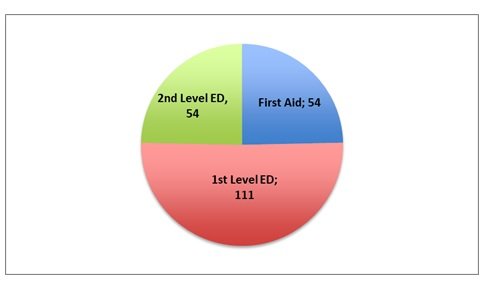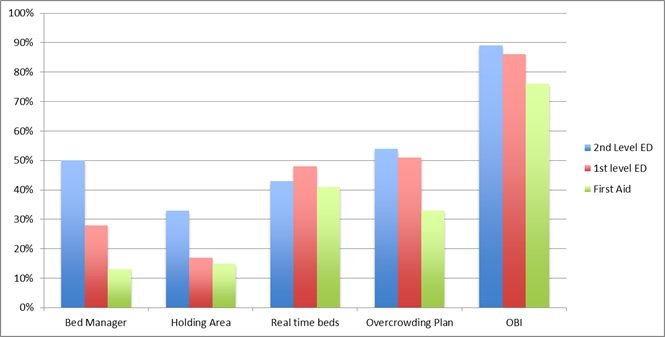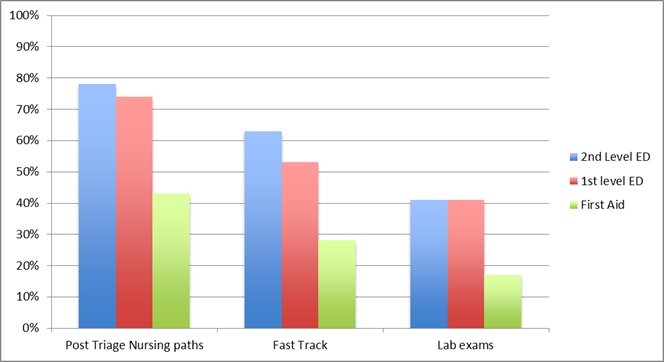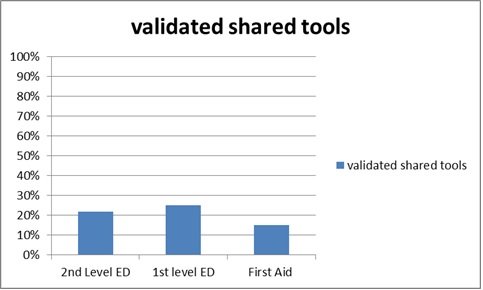- Paola Caporaletti
- Review
Overcrowding in Italian Emergency Department: the survey of “Settimana Nazionale del Pronto Soccorso 2017” SIMEU
- 3/2018-Ottobre
- ISSN 2532-1285
- https://doi.org/10.23832/ITJEM.2018.036
Paola Caporaletti MeCAU, AOU Policlinico Consorziale, Bari
Margherita Maragno MeCAU, P.O. Madonna Delle Grazie, Matera
Matteo Cosi Pronto Soccorso EAS IRCCS Policlinico San Matteo, Pavia
Ombretta Cutuli MeCAU Ospedale Policlinico San Martino, Genova
Stella Ingrassia UOC Pronto Soccorso e Medicina d’Urgenza, IRCCS Fondazione Ca’Granda Ospedale Maggiore Policlinico, Milano
Antonia Cocorocchio CPSI UOC PS/BREVE OSSERVAZIONE AO San Giovanni Addolorata, Roma
Lucia Orlando Settembrini UO di Accettazione e P.S. dell’Az. Ospedaliera Pugliese – Ciaccio, Catanzaro
Valeria Donati DEA Arezzo
Mario Guarino UOSD MeCAU C.T.O. AORN dei Colli, Napoli
Maria Pia Ruggieri UOC PS/BREVE OSSERVAZIONE AO San Giovanni Addolorata, Roma

Abstract
Materials and Methods
Figure 1
Results
Only 22% of hospitals use a validated shared tool to manage overcrowding; the overcrowding level is known by the ED operators in 58% of cases and by the patients in 43% of cases. (fig. 4)
Discussion
Conclusions
The organizational management of emergency departmentshas evolved and continuously evolves to meet ever-more complex health needs. Solutions to ED overcrowding are underused. This survey carried out on the Italian territory, shows the current unsatisfactory organization of EDs and identifies several points on which to work at institutional and corporate levels in order to better cope with the problem of overcrowding in the emergency departments.
Bibliografia
- Carter EJ, Pouch SM, Larson EL. The relationship between emergency department crowding and patient outcomes: a systematic review. J Nurs Scholarsh. 2014 Mar;46(2):106-15.
- PC Sprivulis, JA Da Silva, IG Giacobs, ARL Frazer, GA Jelinek. The association between hospital overcrowding and mortality among patients admitted via Western Australian emergency departments. MJA 2006; 184:208-212
- Richardson DB. Increase in patient mortality at 10 days associated with emergency department overcrowding. Med J Aust. 2006 Mar 6;184(5):213-6.
- Stang AS, Crotts J, Johnson DW, Hartling L, Guttmann A. Crowding measures associated with the quality of emergency department care: a systematic review. Acad Emerg Med. 2015 Jun;22(6):643-56.
- Policy statement SIMEU sul sovraffollamento dei PS/DEA – 2015 http://www.simeu.it/download/articoli/famiglie/302/SIMEU_Policy_Statement_Affollament o_PS_2015.pdf
-
Weiss SJ, Derlet R, Arndahl J, Ernst AA, Richards J, Fernández-Frackelton M, Schwab R, Stair TO, Vicellio P, Levy D, Brautigan M, Johnson A, Nick TG. Estimating the degree of emergency department overcrowding in academic medical centers: results of the National ED Overcrowding Study (NEDOCS). Acad Emerg Med. 2004 Jan;11(1):38-50





